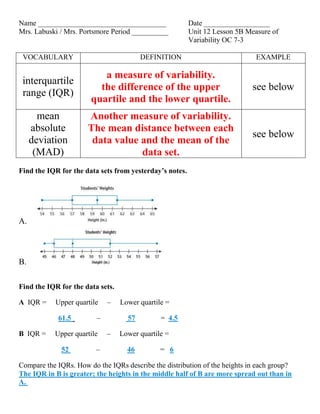
IQR and MAD Lesson
- 1. Name ___________________________________ Date __________________ Mrs. Labuski / Mrs. Portsmore Period __________ Unit 12 Lesson 5B Measure of Variability OC 7-3 VOCABULARY DEFINITION EXAMPLE interquartile range (IQR) a measure of variability. the difference of the upper quartile and the lower quartile. see below mean absolute deviation (MAD) Another measure of variability. The mean distance between each data value and the mean of the data set. see below Find the IQR for the data sets from yesterday’s notes. A. B. Find the IQR for the data sets. A IQR = Upper quartile – Lower quartile = 61.5 – 57 = 4.5 B IQR = Upper quartile – Lower quartile = 52 – 46 = 6 Compare the IQRs. How do the IQRs describe the distribution of the heights in each group? The IQR in B is greater; the heights in the middle half of B are more spread out than in A.
- 2. Find the MAD for the data sets in A. 60, 58, 54, 56, 63, 61, 65, 61, 62, 59, 56, 58 Step 1 Find the mean. Round to the nearest whole number. Step 2 Complete the table. Step 3 To calculate the MAD, find the mean of the values in the second row of the table. Round to the nearest whole number.
- 3. Find the MAD for the data sets in B. 46, 47, 48, 48, 56, 48, 46, 52, 57, 52, 45 Step 1 Find the mean. Round to the nearest whole number. Step 2 Complete the table. Step 3 To calculate the MAD, find the mean of the values in the second row of the table. Round to the nearest whole number. Compare the MADs. How do the MADs describe the distribution of the heights in each group? The MAD in B is greater; in general, the heights in B are farther from the mean than the heights in A.
- 4. Name ___________________________________ Date __________________ Mrs. Labuski / Mrs. Portsmore Period __________ Unit 12 Lesson 5B Measure of Variability OC 7-3 VOCABULARY DEFINITION EXAMPLE interquartile range (IQR) see below mean absolute deviation (MAD) see below Find the IQR for the data sets from yesterday’s notes. A. B. A IQR = Upper quartile – Lower quartile = ___________ – ___________ = ___________ B IQR = Upper quartile – Lower quartile = ___________ – ___________ = ___________ Compare the IQRs. How do the IQRs describe the distribution of the heights in each group? _____________________________________________________________________________ _____________________________________________________________________________
- 5. Find the MAD for the data sets in A. 60, 58, 54, 56, 63, 61, 65, 61, 62, 59, 56, 58 Step 1 Find the mean. Round to the nearest whole number. Step 2 Complete the table. Step 3 To calculate the MAD, find the mean of the values in the second row of the table. Round to the nearest whole number.
- 6. Find the MAD for the data sets in B. 46, 47, 48, 48, 56, 48, 46, 52, 57, 52, 45 Step 1 Find the mean. Round to the nearest whole number. Step 2 Complete the table. Step 3 To calculate the MAD, find the mean of the values in the second row of the table. Round to the nearest whole number. Compare the MADs. How do the MADs describe the distribution of the heights in each group? _____________________________________________________________________________ _____________________________________________________________________________